People and Climate. How Social Infrastructure Powers Adaptation
People, society and nature are facing a changing climate. Climate events such as heatwaves, drought, heavy rainfall and rising sea levels can lead to social disruption. In that case, the impact of climate events extends beyond damage and casualties. The worst-case scenario is that people lose trust in the government and each other, communities fall apart and poverty increases. These examples show that climate events can have both physical and societal consequences. Conversely, the social context partly determines how well people are able to cope with climate events. Those with a strong network or sufficient resources are generally less likely to encounter severe problems and more likely to recover more quickly.
Dutch climate adaptation policy pays too little attention to these social factors. The focus is on physical protection measures. Although these are essential, they are not sufficient. The WRR argues that climate resilience in the Netherlands improves if the government also invests in the country’s social infrastructure, which enables people to look out for each other, increases mutual trust and offers perspectives for action.
